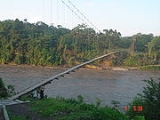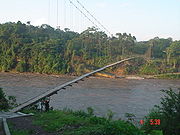
Aguarico River
Encyclopedia

River
A river is a natural watercourse, usually freshwater, flowing towards an ocean, a lake, a sea, or another river. In a few cases, a river simply flows into the ground or dries up completely before reaching another body of water. Small rivers may also be called by several other names, including...
in northern Ecuador
Ecuador
Ecuador , officially the Republic of Ecuador is a representative democratic republic in South America, bordered by Colombia on the north, Peru on the east and south, and by the Pacific Ocean to the west. It is one of only two countries in South America, along with Chile, that do not have a border...
. It is the main river of the Sucumbíos province. In the last part of its course it is the Ecuadorian-Peru
Peru
Peru , officially the Republic of Peru , is a country in western South America. It is bordered on the north by Ecuador and Colombia, on the east by Brazil, on the southeast by Bolivia, on the south by Chile, and on the west by the Pacific Ocean....
vian border. It empties into the Napo River
Napo River
The Napo is a tributary to the Amazon River that rises in Ecuador on the flanks of the volcanoes of Antisana, Sincholagua and Cotopaxi.The total length of 1075 km. Catchment area of 100,518 square kilometers...
. It has a length of 390 kilometers, of which the last 50 kilometers of its course extend along the natural border between Ecuador and Peru
Peru
Peru , officially the Republic of Peru , is a country in western South America. It is bordered on the north by Ecuador and Colombia, on the east by Brazil, on the southeast by Bolivia, on the south by Chile, and on the west by the Pacific Ocean....
(in the department of Loreto
Loreto Region
Loreto is Peru's northernmost region. Covering almost one-third of Peru's territory, Loreto is by far the nation's largest region and also one of the most sparsely populated ones, due to its remote location in the Amazon Rainforest...
). The lower course of the Aguarico river was finalized and legally fixed as part of the long-disputed Ecuador-Peru frontier according to The Rio de Janeiro Protocol of 1942. Ecuador unilaterally denounced the protocol in 1960, however a new agreement was signed in 1999 validating the pre-existing protocol .
The Aguarico river is a river that flows almost completely by the province of Sucumbíos, in the north of Ecuador, being the main river of the province. In its average course it flows closely near the Reserve of Production Faunística Cuyabeno. In the last part of its course it flows near the Ecuadorian-Peruvian border. Finally it ends at the Napo river, in the same border, a little over the locality the town of Pantoja in Loreto, Peru.
History
In 1541, Gonzalo PizarroGonzalo Pizarro
Gonzalo Pizarro y Alonso was a Spanish conquistador and younger paternal half-brother of Francisco Pizarro, the conqueror of the Inca Empire...
and Francisco de Orellana
Francisco de Orellana
Francisco de Orellana was a Spanish explorer and conquistador. He completed the first known navigation of the length of the Amazon River, which was originally named for him...
constructed a sailboat, the San Pedro, and followed the courses of the Colca River
Colca River
The Colca River is a Peruvian river that flows deep in the rugged Andes of southern Peru....
and the Napo River until the confluence of this one with the Aguarico River and the Curaray River
Curaray River
The Curaray River is a river in eastern Ecuador and is part of the Amazon River basin. The land along the river is home to several indigenous people groups including the Quechua and Huaorani...
, where they lacked the proper amount of provisions and supplies, including food. Several men did not survive, and it is estimated that 140 of 220 Spaniards and 3,000 of the 4,000 Indians who composed the expedition were amongst this number. They decided then (22 of February of 1542) that Orellana would continue down the Aguarico River in search of food. They accompanied about fifty men to go with him. Incapable to overcome the river, Orellana waited for Pizarro. Finally Pizarro sent three men with a message to Orellana for him to begin the construction of a new boat, the Victoria. Meanwhile, Pizarro had returned towards Quito
Quito
San Francisco de Quito, most often called Quito , is the capital city of Ecuador in northwestern South America. It is located in north-central Ecuador in the Guayllabamba river basin, on the eastern slopes of Pichincha, an active stratovolcano in the Andes mountains...
by another route towards the north, with only 80 men, those of which that remained alive.
Indigenous Tribes
In the highest part of the Aguarico River live the indigenousIndigenous peoples
Indigenous peoples are ethnic groups that are defined as indigenous according to one of the various definitions of the term, there is no universally accepted definition but most of which carry connotations of being the "original inhabitants" of a territory....
Sioni
Siona people
The Siona people are an indigenous ethnic group living in the Ecuadorian Amazon or Oriente , and in Colombia...
. The Siona peoples belong to the western Tucanoan
Tucanoan languages
Tucanoan is a language family of Colombia, Brazil, Ecuador, and Peru.-Family division:There are two dozen Tucanoan languages:*Western Tucanoan**Correguaje **Tama **Macaguaje ...
language family, and their official languages are the Piohe (or Pioche) dialects and Spanish
Spanish language
Spanish , also known as Castilian , is a Romance language in the Ibero-Romance group that evolved from several languages and dialects in central-northern Iberia around the 9th century and gradually spread with the expansion of the Kingdom of Castile into central and southern Iberia during the...
as well as a mixture of the two, which is sometimes called Pioche-Sione. At present they are a group of approximately 172 people reunited in 51 families. Their economic activities are based mainly on hunting
Hunting
Hunting is the practice of pursuing any living thing, usually wildlife, for food, recreation, or trade. In present-day use, the term refers to lawful hunting, as distinguished from poaching, which is the killing, trapping or capture of the hunted species contrary to applicable law...
, fishing
Fishing
Fishing is the activity of trying to catch wild fish. Fish are normally caught in the wild. Techniques for catching fish include hand gathering, spearing, netting, angling and trapping....
and sometimes tourism
Tourism
Tourism is travel for recreational, leisure or business purposes. The World Tourism Organization defines tourists as people "traveling to and staying in places outside their usual environment for not more than one consecutive year for leisure, business and other purposes".Tourism has become a...
. Some of the problems that the community must face in the present era are environmental contamination and the over-exploitation of lumber
Lumber
Lumber or timber is wood in any of its stages from felling through readiness for use as structural material for construction, or wood pulp for paper production....
.

